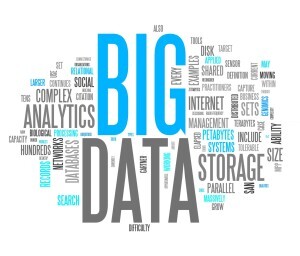 While Big Data has received a lot of attention over the last three years, the “Data” part has been a key component for leading companies for much, much longer. The “Big” part is only possible now because tools like Hadoop that store, access, and analyze massive volumes of data have emerged from web pioneers such as Google, Yahoo and Facebook and become commercially viable solutions for all enterprises.
While Big Data has received a lot of attention over the last three years, the “Data” part has been a key component for leading companies for much, much longer. The “Big” part is only possible now because tools like Hadoop that store, access, and analyze massive volumes of data have emerged from web pioneers such as Google, Yahoo and Facebook and become commercially viable solutions for all enterprises.
 While Big Data has received a lot of attention over the last three years, the “Data” part has been a key component for leading companies for much, much longer. The “Big” part is only possible now because tools like Hadoop that store, access, and analyze massive volumes of data have emerged from web pioneers such as Google, Yahoo and Facebook and become commercially viable solutions for all enterprises. But the real reason people are excited about Big Data is because it enables new, transformative ways of thinking about old problems.
While Big Data has received a lot of attention over the last three years, the “Data” part has been a key component for leading companies for much, much longer. The “Big” part is only possible now because tools like Hadoop that store, access, and analyze massive volumes of data have emerged from web pioneers such as Google, Yahoo and Facebook and become commercially viable solutions for all enterprises. But the real reason people are excited about Big Data is because it enables new, transformative ways of thinking about old problems.
By looking at higher volumes of data from a greater variety of sources, smart companies have been unlocking Big Ideas from their Big Data. Now, we’ve entered an era where systems can digest, process and query that data with incredible velocity, unlocking real-time applications that make Big Data faster and more actionable. For data-driven startups, innovation like this opens doors to disruptive applications that get a lot of attention (think of Uber’s rebooting of the taxi model or Nest’s data-powered thermostat).
However, more traditional industries are using Big Data to rethink seemingly “boring” things like retail sales, fraud detection and inventory levels. They’re looking at shaving seconds from an activity or boosting sales by percentage points. These are activities that may lack the big splash of an IPO but generate huge gains when repeated over and over again in the course of their operations.
Here’s three ways how traditional industries are putting Big Data to use for their bottom line.
Consumer Marketing
For consumer marketers, the old adage still holds true: reach the right audience with the right message at the right time. This is the holy grail of effective consumer marketing and there are many approaches to the goal. Think of Amazon’s recommendation engine: it’s an immediate message to a singular person based on his or her actions, and the actions of similar people. This is a smart system, powered by Big Data.
The other end of the spectrum would be a prime time TV ad or a roadside billboard. They are mass marketing at a time when the person cannot make an immediate purchase. Email campaigns used to be like this, but now, companies are harnessing campaign management tools to harness insights to increase the effectiveness of their outreach with personalization.
The next generation of consumer marketing offers multi-touch capabilities that seamlessly connect a personalized message across media, devices and locations to drive sales. Plus, the real-time data generated by sensors (which create an Internet of Things) means that consumer marketers will be able to take advantage of location-based data like Apple’s iBeacon in stores as well external data like weather forecasts or social media sentiment that create a truly relevant and targeted buying environment.
Fraud Detection
Fraud and financial crime is serious business, just ask the companies and individuals that have been victimized in the past year. From Kroll’s 2013/2014 Global Fraud Report, the size and reach of fraud is staggering:
- Fraud and financial crime have been estimated at over $3.5 trillion annually
- Identity theft alone costs Americans over $24 billion, which is $10 billion more than all other property crimes
- 70% of all companies have experienced some type of fraud
With millions of transactions occurring per day, this financial data is most certainly big, making identifying a fraudulent purchase a challenge of pattern recognition. Patterns typically become stronger with more data points which gives financial services companies, retails and other high-volume players the impetus to look at as much data as possible. However, when a bank has to process voluminous historical data along with real-time data nightly to detect fraud, it becomes nearly impossible to keep up with both the volume and velocity of data.
Beyond just transaction data, massive sets of location data are often leveraged to increase the effectiveness of fraud detection. Past transactions indicate where and when a consumer usually shops. If a person purchased a plane ticket to New York, it would make sense that transactions will start to appear in New York during the trip. If someone is on a road trip, it is possible to extrapolate the next step of charges (e.g., gas) based on major interstate routes. If someone (or their phone – location data that may also be available) is thousands of miles from where a transaction is initiated, it is very likely that the transaction is fraudulent.
While volume can be the key to recognizing fraud, velocity is the key to stopping fraud. New real-time Big Data platforms enable companies to process massive quantities of historical information and crosscheck new transactions in real-time to spot patterns and halt a transaction before it occurs. By having real-time data at their fingertips, data scientists can also look at new information on the fly, evolving countermeasures just as criminals are adapting to security that’s already in place. With every measure of fraud prevention, companies can lower their costs, protect their assets and safeguard their customers.
Logistics
Thanks to some multi-million dollar TV advertising, the idea of logistics is probably better understood by the layperson than ever before. Yet the picture they would draw on a white board would be ten to twenty years out of date, especially within a best-in-class organization where it’s not just a truck, a warehouse and a store any longer. Transporting, holding, stocking and picking goods are huge cost centers for a retailer. Every touch point between the manufacturer and the buyer costs money, and every second an item sits on a shelf, its profit margin slowly erodes.
There have been many ways that enterprises have attempted to improve logistics efficiency through data, such as massive warehouse management system software and advanced planning systems that can predict the best quantity and location of inventory to avoid stock outs or dead inventory. The Big Data era builds on these concepts and takes advantage of advancements in data collection to make logistics faster, smarter and more efficient.
For example, RFID tags and sensors create a passive network of communication, tracking each item and its location. This boosts productivity when goods are shipped, received, picked and packed because goods can move without the scanning of barcodes. This constant flow of real-time data is a goldmine of information that can be the catalyst for new insights and optimizations.
A new vision of logistics for major retailers is just-in-time delivery. Imagine a regional warehouse of a big box store. A truck pulls in one side with twenty washing machines while on the opposite dock, five trucks wait to go to five different stores, each needing washing machines. The delivery truck does not dock early or late – only on time – and the inventory merely passes through, meaning it does not have to be put away, picked and shipped again later. It’s in, it’s out, and it’s on its way to be turned into profit instead of cost.
The Power of Big Data can be realized in any Industry
These three examples may be about certain applications, but they all show how the right use of data can transform existing processes to create real results. While Big Data has the power to change the world, you have the opportunity to use it to change your own operations. Incremental, data-driven change may not get the headlines, but it could get your business to the head of its field.







